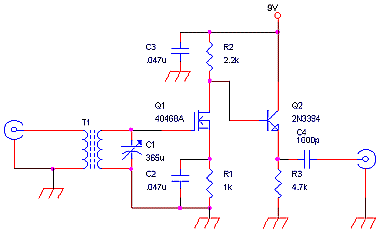|
Add-on
loop amplifier
by Bruce
Carter
Simple, easy
to build amplifiers for your antenna signals, be it from a loop
or long wire antenna, is becoming increasingly difficult to find.
Here are
two versions, based on articles from around 1970. The amplifiers
was done by different authors, but describe an almost identical
circuit, shown below:

AM radio RF Amplifer
(click here for larger photo)
The first
version had a 3PDT switch that not only acted as a power switch,
but also allowed the user to bypass the amplifier. This would
be very useful for areas with strong stations, to avoid overloading
the receiver.
The second version utilized a ferrite bar antenna, which
severely compromised sensitivity. It did, however, include PCB
artwork.
I would suggest
that this RF amp would be most helpful when used with the AM
loop antenna. In this case, simply delete T1, which is mounted
off the board anyway. C1 will serve as the tuning capacitor for
the loop.
If a long
wire antenna is used with (or without) a coupler,
you will need T1. T1 is an AM RF transformer, and is a type that
is becoming increasingly difficult to find. An AM loopstick antenna
could probably be substituted, with the smaller number of turns
being used for the secondary. I would suggest using a small ferrite
slug, or breaking off the excess length of ferrite.
I have no
idea whether the RCA 40468A FET is still available or not. It
came in a 4 pin metal can - with the 4th pin connected to the
substrate. I have successfully substituted other N-channel devices,
such as the HEP-802 - which comes in a plastic TO-92 package.
Simply ignore the substrate connection.
Other good quality N-channel FET's can probably be used as well.
Both articles stressed handling precautions for FET's. Even though
FET's today are much better protected than in the past, static
can still damage them. Use a wrist strap and grounded soldering
station during assembly.
I cannot
give enough praise to this design. It provides about 40dB of gain,
and the main problem you will encounter is overloading.

This page is based on two articles:
"Pre-amp for the Broadcast Band", Victor Kell, Electronics Illustrated,
March 1969, pages 56-59
"Big Booster for the BCB", Herb Friedman, Electronics Illustrated,
March 1971, pages 77-80
|





